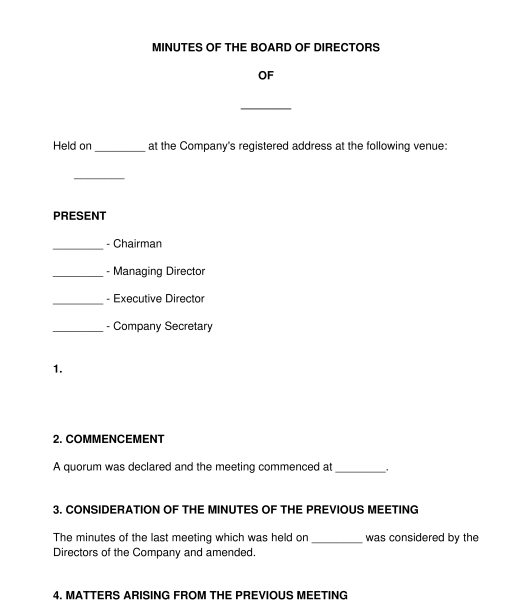 11/09/2025
11/09/2025

Answer a few questions and your document is created automatically.

Your document is ready! You will receive it in Word and PDF formats. You will be able to modify it.

 11/09/2025
11/09/2025
 Word and PDF
Word and PDF
 2 to 4 pages
2 to 4 pages



The Minutes of a Board Meeting is a formal written document that outlines the discussions, decisions, and actions taken during a meeting of a company's board of directors. The minutes serve as an official and legal record of what was discussed during the meeting and are an essential part of corporate records.
The minutes of a board meeting are considered a corporate record and are required by law or regulations. They provide transparency and a historical reference for the decisions and discussions during the meeting. In addition, minutes serve as a tool for communication among board members and can be used as a reference for future meetings or legal matters.
Note that this document is different from the Minutes of Members' Meeting, which is designed to record discussions in a meeting of the shareholders or members of a company.
For better understanding, the following should be considered before and during a board meeting:
This document provides a comprehensive overview of the meeting's proceedings and typically includes the following components:
Usually, the company secretary prepares the minutes after the directors finish their board meeting to record the key discussions and resolutions passed during the meeting. This document is perfectly designed to provide a prescribed format to ensure consistency and clarity. Following this standardized document helps make the minutes of board meetings easy to understand and use as an official record.
The person preparing this document will enter the required information, such as the name of the company, the type of meeting convened, the date and time of the meeting, the agenda of the meeting, the decisions or resolutions passed (if any) and actions or steps to be taken after the meeting.
After completing the document, it should be printed and signed by the chairman and the company secretary. After this, the general practice is that the company secretary is required to circulate the minutes at the next meeting to all the directors and other participants of the meeting for consideration.
Note that if the directors made a corporate decision or passed a resolution, such as the appointment or removal of the company secretary or other resolution, the company must make a corporate filing at the Corporate Affairs Commission. The legal department or an external counsel must be notified to make this filing.
The Companies and Allied Matters Act, 2020 is the applicable law.
You fill out a form. The document is created before your eyes as you respond to the questions.
At the end, you receive it in Word and PDF formats. You can modify it and reuse it.
Guides to help you
Minutes of Board of Directors Meeting - FREE - template
Country: Nigeria